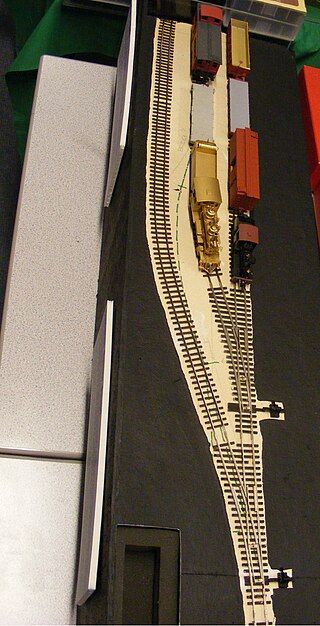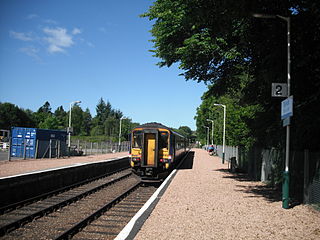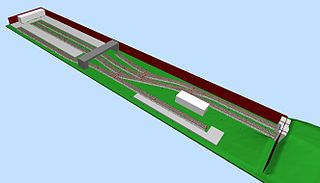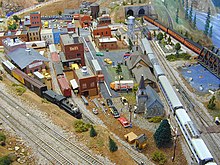
In railroad structures, and rail terminology, a wye or triangular junction is a triangular joining arrangement of three rail lines with a railroad switch at each corner connecting to the incoming lines. A turning wye is a specific case.

A siding, in rail terminology, is a low-speed track section distinct from a running line or through route such as a main line, branch line, or spur. It may connect to through track or to other sidings at either end. Sidings often have lighter rails, meant for lower speed or less heavy traffic, and few, if any, signals. Sidings connected at both ends to a running line are commonly known as loops; those not so connected may be referred to as single-ended or dead-end sidings, or stubs.

A rail yard, railway yard, railroad yard (US) or simply yard, is a series of tracks in a rail network for storing, sorting, or loading and unloading rail vehicles and locomotives. Yards have many tracks in parallel for keeping rolling stock or unused locomotives stored off the main line, so that they do not obstruct the flow of traffic. Cars or wagons are moved around by specially designed yard switcher locomotives (US) or shunter locomotives (UK), a type of locomotive. Cars or wagons in a yard may be sorted by numerous categories, including railway company, loaded or unloaded, destination, car type, or whether they need repairs. Yards are normally built where there is a need to store rail vehicles while they are not being loaded or unloaded, or are waiting to be assembled into trains. Large yards may have a tower to control operations.

A passing loop or passing siding is a place on a single line railway or tramway, often located at or near a station, where trains or trams travelling in opposite directions can pass each other. Trains/trams going in the same direction can also overtake, provided that the signalling arrangement allows it. A passing loop is double-ended and connected to the main track at both ends, though a dead end siding known as a refuge siding, which is much less convenient, can be used. A similar arrangement is used on the gauntlet track of cable railways and funiculars, and in passing places on single-track roads.
Rail transport – means of conveyance of passengers and goods by way of wheeled vehicles running on rail tracks consisting of steel rails installed on sleepers/ties and ballast.

Bridgwater railway station serves the market town of Bridgwater in Somerset, England. It is on the Bristol to Taunton Line and is operated by Great Western Railway. It is 151 miles 47 chains from the zero point at London Paddington via Box.

Drem railway station serves the small village of Drem in East Lothian, 5 miles (8 km) from the seaside town of North Berwick in Scotland. It is located on the East Coast Main Line (ECML) 18 miles (29 km) east of Edinburgh Waverley. Passenger services are provided on the ScotRail North Berwick Line, and the junction where the North Berwick branch diverges from the ECML is a short distance to the east of the station.
This article contains a list of jargon used to varying degrees by railfans, trainspotters, and railway employees in the United Kingdom, including nicknames for various locomotives and multiple units. Although not exhaustive, many of the entries in this list appear from time to time in specialist, rail-related publications. There may be significant regional variation in usage.

A fiddle yard or staging yard is a collection of model railway tracks that are hidden from view and allow trains to be stored and manipulated by the operators. These tracks are used to allow most model railways to be operated in a realistic manner. Whilst it is possible to have a realistic shunting yard in view, its operation is generally unreliable with models.

Taynuilt railway station is a railway station serving the village of Taynuilt in western Scotland. This station is on the Oban branch of the West Highland Line, originally part of the Callander and Oban Railway, between Falls of Cruachan and Connel Ferry, sited 58 miles 55 chains (94.4 km) from Callander via Glen Ogle. ScotRail manage the station and operate all services.
Train shunting puzzles, also often called railway shunting puzzles or railroad switching puzzles, are a type of puzzle.
Timesaver is a well-known model railroad train shunting puzzle created by John Allen. It consists of a specific track layout, a set of initial conditions, a defined goal, and rules which must be obeyed while performing the shunting operations.

A headshunt is a short length of track provided to release locomotives at terminal platforms, or to allow shunting to take place clear of main lines.

The Swanley New Barn Railway is a 7+1⁄4 in gauge railway located in Swanley Park, Swanley, Kent, United Kingdom. It is signalled throughout with the signals being controlled from New Barn Station which also serves as a terminus.

The Los Angeles Live Steamers Railroad Museum (LALSRM) is a non-profit public-benefit corporation founded in 1956 by live steam enthusiasts for the purpose of educating the public about railroad history and lore, and to promote live steam and scale model railroad technology. The museum is located in Griffith Park in Los Angeles, California and is open from 11 a.m. to 3 p.m. every Sunday weather permitting. In 1956, all of the model locomotives were steam-powered, hence the name "Live Steamers". Over the years, gasoline-powered models of diesel locomotives and battery-electric locomotives and trolleys have also become popular. The museum operates a 7+1⁄2 in gauge miniature railway on which these locomotives pull trains that the public can ride.

The application of railway signals on a rail layout is determined by various factors, principally the location of points of potential conflict, as well as the speed and frequency of trains and the movements they require to make.

A train station, railway station, railroad station, or railway depot is a railway facility where trains stop to load or unload passengers, freight, or both. It generally consists of at least one platform, one track, and a station building providing such ancillary services as ticket sales, waiting rooms, and baggage/freight service. If a station is on a single-track line, it often has a passing loop to facilitate traffic movements.

Minories is a 'deceptively simple' design for a model railway layout, designed by C. J. Freezer. The design was first published in Railway Modeller in 1957 and it became a regular of Peco's many collected plans books afterwards. It is notable as an influential design, more than as a single instance of the model. The design was an attempt to model an interesting urban passenger terminus in the minimum space, allowing much opportunity for operating trains, rather than scenic modelling. Freezer was the editor of Railway Modeller and Minories, with its developments, made regular appearances throughout the years.

A pizza layout is a model railway laid out as a circle of the smallest workable radius of curve, on the smallest possible square or circular baseboard. This baseboard can be so small as to look as if it would fit into a pizza box, hence the name.
Modern railway signalling in Thailand on the Mainline employ Color Light Signal and Computer-based interlocking. SRT currently implementing CTC to link whole country signalling system together using Fiber Optic network. This includes Recent Double Tracking Projects for all mainline extend from Bangkok.

















